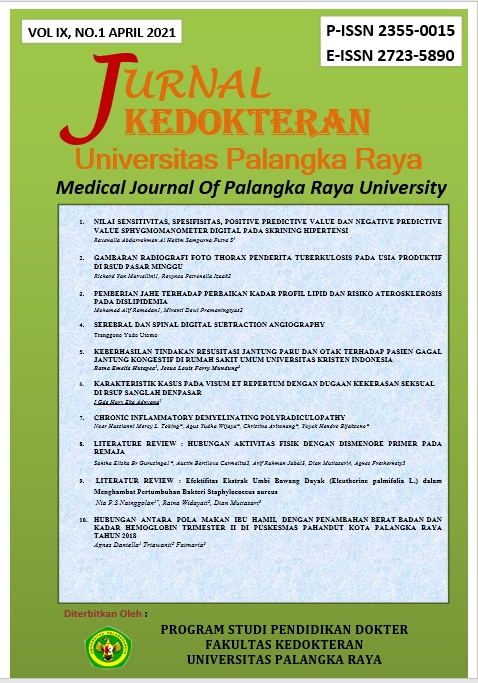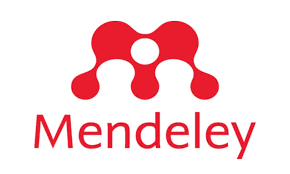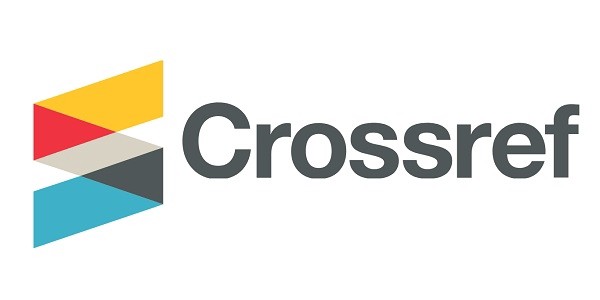PEMBERIAN JAHE TERHADAP PERBAIKAN KADAR PROFIL LIPID DAN RISIKO ATEROSKLEROSIS PADA DISLIPIDEMIA
DOI:
https://doi.org/10.37304/jkupr.v9i1.2861Keywords:
Dislipidemia, Profil Lipid, Jahe, AterosklerosisAbstract
Dislipidemia merupakan salah satu faktor risiko terjadinya penyakit jantung coroner (PJK) yakni aterosklerosis. Menurut World Health Organization (WHO), angka kejadian dislipidemia tertinggi terjadi di Eropa dan dapat meningkatkan risiko terjadinya stroke iskemik. Jahe (Zingiber officinale) merupakan tanaman herbal yang memiliki beberapa kandungan untuk memperbaiki kadar profil lipid. Pemberian jahe dapat mempengaruhi kadar profil lipid dengan beberapa dosis dan jenis ekstrak jahe. Beberapa penelitian menyebutkan kadar flavonoid pada jahe dapat menurunkan kadar kolesterol dengan meningkatkan sintesis asam empedu. Kandungan 6-gingerol pada jahe dapat menurunkan kadar Low-density lipoprotein cholesterol (LDL-C) lewat penurunan kadar C-reactive protein (CRP) dan prostaglandin (PGE2). Peningkatan kadar High-density lipoprotein cholesterol (HDL-C) dipengaruhi oleh kandungan niacin pada jahe. Trigliserida dapat menagalami penurunan kadar didalam serum dengan meningkatkan aktivasi enzim lipoprotein lipase (LPL). Efek antioksidan pada jahe dapat menghambat mekanisme oksidasi LDL-C dengan inhibisi enzim reactive-oxygen-generating sehingga dapat menurunkan risiko aterosklerosis. Studi literatur ini menyimpulkan jahe berperan dalam perubahan profil lipid dan penurunan risiko dislipidemia akibat aterosklerosis. Hal ini dapat menjadi rekomendasi untuk penelitian eksperimental.
Downloads
References
Helkin A, Stein JJ, Lin S, Siddiqui S, Maier KG, Gahtan V. Dyslipidemia Part 1 — Review of
Lipid Metabolism and Vascular Cell Physiology. 2016; 50: 107–118.
Jocelyne V, Moor A, Amougou SN, Ombotto S, Ntone F, Wouamba DE et al.Dyslipidemia in Patients with a Cardiovascular Risk and Disease at the University Teaching Hospital of Yaoundé , Cameroon. 2017; 2017.
Nelson RH. Hyperlipidemia as a Risk Factor for Cardiovascular Disease. 2014; 40: 195–211.
Cabezas MC, Burggraaf B, Klop B. Dyslipidemias in clinical practice. Clin Chim Acta 2018; 487: 117–125.
Lin C, Chang Y, Chien S, Lin Y, Yeh H. Epidemiology of Dyslipidemia in the Asia Pacific Region. 2018; 12: 4–8.
Noubiap JJ, Bigna JJ, Nansseu JR, Nyaga UF, Balti EV, Echouffo-tcheugui JB. Articles
Prevalence of dyslipidaemia among adults in Africa : a systematic review and meta-analysis. 2018; : 998–1007.
Narindrarangkura P, Bosl W, Rangsin R, Hatthachote P. Prevalence of dyslipidemia associated with complications in diabetic patients : a nationwide study in Thailand. 2019; 3: 1–8.
Liu X, Yu S, Mao Z, Li Y, Zhang H, Yang K et al. Dyslipidemia prevalence , awareness ,
treatment , control , and risk factors in Chinese rural population : the Henan rural cohort study. 2018; : 1–12.
Szkup M, Jurczak A, Karakiewicz B, Kotwas A, Kopeć J, Grochans E. Influence of cigarette smoking on hormone and lipid metabolism in women in late reproductive stage. 2018; : 109–115.
Mohammed A, Ali A, Elamin M, El-nour M, Mohamed S. Total phenolic and flavonoid
contents and antioxidant activity of ginger ( Zingiber officinale Rosc .) rhizome , callus and callus treated with some elicitors. J Genet Eng Biotechnol 2018; 16: 677–682.
Arablou T, Aryaeian N. The effect of ginger (Zingiber Officinale) as an ancient medicinal plant on improving blood lipids. 2018; 12: 11–15.
Ghasemzadeh A, Jaafar HZE, Rahmat A. Synthesis of Phenolics and Flavonoids in Ginger ( Zingiber officinale Roscoe ) and Their Effects on Photosynthesis Rate. 2010; : 4539–4555.
Tabibi H, Imani H, Atabak S, Najafi I, Hedayati M, Rahmani L et al. EFFECTS OF GINGER ON SERUM LIPIDS AND LIPOPROTEINS IN PERITONEAL DIALYSIS. 2016; 36: 140–145.
Stahel P, Xiao C, Hegele RA, Lewis GF. The Atherogenic Dyslipidemia Complex and Novel Approaches to Cardiovascular Disease Prevention in Diabetes. Can J Cardiol 2018; 34: 595–604.
Ramasamy I. Clinica Chimica Acta Update on the molecular biology of dyslipidemias. Clin Chim Acta 2016; 454: 143–185.
Bergheanu SC. Pathophysiology and treatment of atherosclerosis Current view and future perspective on lipoprotein modification treatment. 2017; : 231–242.
Khosravani M, Azarbayjani MA, Abolmaesoomi M, Akbari M, Yusof A, Abidin NZ et al. Ginger extract and aerobic training reduces lipid profile in high-fat fed diet rats. 2016; : 1617–1622.
Arablou T, Aryaeian N, Valizadeh M, Sharifi F, Hosseini A, Djalali M. The effect of ginger
consumption on glycemic status , lipid profile and some inflammatory markers in patients with type 2 diabetes mellitus. 2014; 7486. doi:10.3109/09637486.2014.880671.
Hapsari HP, Rahayuningsih HM. PENGARUH PEMBERIAN JAHE MERAH (Zingiber
officinale var rubrum) TERHADAP KADAR KOLESTEROL LDL WANITA DISLIPIDEMIA. 2014; 3: 871–879.
Yassin EMENAZ. Antihypercholesterolaemic effect of ginger rhizome ( Zingiber officinale) in rats. 2010; : 309–315.
Wang J, Ke W, Bao R, Hu X, Chen F. Beneficial effects of ginger Zingiber officinale Roscoe on obesity and metabolic syndrome : a review. 2017; : 1–16.
Mazidi M, Gao H, Rezaie P, Ferns GA. The effect of ginger supplementation on serum Creactive protein, lipid profile and glycaemia: a systematic review and meta-analysis. 2016; 1: 1–9.
Heras N de la, Valero-Munoz M, Martin-Fernandez B, Ballesteros S, Lopez-Farre A,
Ruiz-Roso B et al. Molecular factors involved in the hypolipidemic and insulin sensitizing effects of a ginger (Zingiber officinale Roscoe) extract in rats fed a high-fat diet. Appl Physiol Nutr Metab 2017; 2: 209–215.
Bhandari U, Pillai KK. Effect of ethanolic extract of Zingiber officinale on dyslipidaemia in diabetic rats. 2005; 97: 227–230.
Elseweidy MM, Younis NN, Elswefy SE, Abdallah FR, Elnagar G, Kassem HM. Natural
Product Research : Formerly Natural Product Letters Atheroprotective potentials of
curcuminoids against ginger extract in hypercholesterolaemic rabbits. 2014; : 37–41.
Garg R. Association of atherosclerosis with dyslipidemia and co-morbid conditions : A
descriptive study. 2015; 6. doi:10.4103/0976-9668.149117.
Al-noory AS, Amreen A, Hymoor S. Antihyperlipidemic effects of ginger extracts in
alloxan-induced diabetes and propylthiouracilinduced hypothyroidism in ( rats ). 2013; 5: 157–162





















